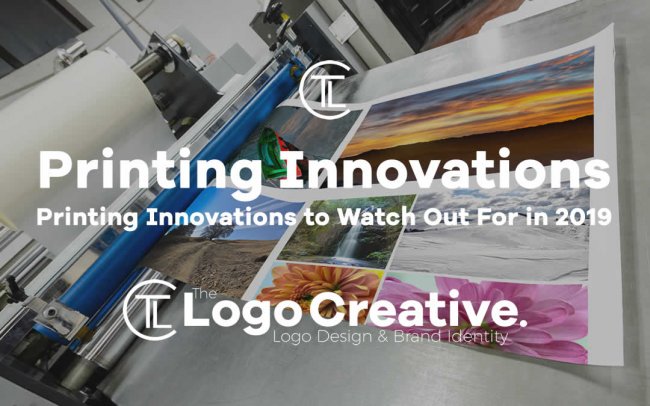The print industry has developed and evolved so much over recent years and we see no signs of that stopping in 2019. Businesses all over the world are always looking for new ways of innovating and improving their services and the technology they use. We’ve cast our eye far and wide to see the printing innovations you can expect to see in 2019.
Table of Contents
Print Innovations in 2019
3D Printing
3D printing would probably have made the list for innovations in 2018, 2017, 2016 – you get the idea. It’s not a new concept but the common issues that 3D printing faces are ironed out with each new development.
It doesn’t take a genius to guess that 3D printing’s meteoric rise will continue this year, increasing its popularity and usage. With more people using it, we can expect its accessibility to improve, especially with digital screens adding to the process.
It still hasn’t quite broken into being mainstream but for the printers that do specialise in it, it’ll continue to be at the forefront of innovation this year. Like with all gadgets and new technologies, 3D printers are going to become faster and cheaper. It won’t be long before they’re commercially viable for most businesses, especially due to the positive impact they can have.
2019’s big new addition is 3D metal printing which is poised to be the only thing anyone will talk about.
It’s unlikely to completely replace plastic as the material of choice for 3D printers but the implications it can have for the wider manufacturing industry will be worth keeping an eye on. The major players in the industry all have new models in the pipeline that are capable of carrying out 3D metal printing, but we’ll have to wait and see for a closer look.
As well as the 3D printing we’ve already mentioned, printers will see a rise in demand for 3D-style effects. Haptic printing has been able to produce incredible results for years, but the process was seen as being too slow and expensive. Customers loved what was possible but brands found that it wasn’t cost-effective.
But, recent innovations and improvements have made haptic printing more viable for brands so we’re starting to see the results. 3D-style prints are popular for a few different reasons. The results speak for themselves – they’re just really good to look at. Plus, they’re fantastic conversation starters and can help your brand to stand out from the crowd.
They add depth to a print, elevating its impact and they’re great for strengthening relationships with consumers. This is because they appreciate the effort and time you’ve taken to create something so impressive. It shows you’re worth their business.
Brand-New Print Tech
There are so many new and exciting print technologies that we’re seeing more of that it’s difficult to keep up. At events and exhibitions around the world, businesses are showing off their new tech to an eager audience.
Tech like light-based installations is going to be on the rise this year. At the 2018 Design Show, we saw the world’s first illuminated wallpaper. It had been created by sewing wires into the fabric of the printed wallpaper. It was a fusion of style, tech, and innovation.
Displays that use a combination of large format prints and architectural mapping are another example of different methods coming together to create something amazing. We expect to see more collaborations and innovations like this in the future.
New technologies are going to be introduced at both ends of the scale. We’ll see more jaw-dropping installations like the ones mentioned above but we can also expect standard office printers to get an upgrade in 2019.
Last year we saw some smaller printers experimenting with voice recognition. It’s on our phones and in our cars so why shouldn’t it be compatible with printers? Today’s consumer is used to smart devices and there’s no reason printers should be any different.
Voice control software is something to watch out for in 2019. There’s definitely an opportunity for companies to implement voice recognition. If they can get the right balance and show that it improves efficiency, then this innovation might be rolled out across the whole industry.
Going Green
The campaign to make the print industry more environmentally friendly has been in full swing for years now. There have been great strides over the last few years that’ll continue in 2019. One of the biggest changes has been for businesses to use sustainable materials.
If companies haven’t already made the switch, then it’s now or never, especially with today’s consumer being much more environmentally aware. Making sure they use recycled materials where they can and paper from sustainable sources are both important ways of reducing waste.
One of the biggest contributors to the industry’s carbon footprint is unnecessary packaging. Reductions in padding, boxing and wrapping will change the way that some items are packaged but will drastically reduce waste too.
Something that’s a little less obvious than reducing packaging is the ink that’s used by many printers. Some, but not all, have made the switch to inks, coatings, and chemicals that are vegetable-based. Inks that are petroleum based are more harmful and can eventually contaminate the local groundwater and soil.
The vegetable-based alternatives are much better for the environment while still producing high-quality finishes. In fact, these eco-friendly inks are easier to remove from paper during the recycling process – making them even better for the environment.
Finally, the amount of energy used by printers is gradually being reduced with each new generation of hardware. Plus, printing facilities themselves are part of a growing switch to cleaner energy – using energy-efficient bulbs and power saving equipment.
Print Marketing
The demise of print marketing has been greatly exaggerated. Businesses that focus solely on digital marketing strategies are missing out on a huge marketplace. Innovations to techniques and equipment have resulted in better quality print materials being created.
Whether it’s a newsletter, brochure or flyer, printers are now able to create marketing materials that are high-quality, engaging and attention-grabbing. With so much online competition, they’ve had to up their game and the results really are remarkable.
When LED UV Litho technology is used, the finished product is sharper and more vibrant. Colours are more vivid and the quality of the paper means that you have something that’s truly worth treasuring.
Keeping with the environmentally friendly theme, new printing techniques, like LED UV, are green because there’s no heat generated and the energy needed to carry out the print is low.
And who said print and digital marketing can’t work hand in hand? Combining the two can lead to effective campaigns and is a surefire way of reaching as many potential customers as possible. Think about things like augmented print and bespoke landing pages that you can track.
We expect digital printing to continue to grow in importance in 2019. Brands have already seen the success of using digital printing to create bespoke, personalised packaging for consumers. The “Share a Coke with…” campaign was a huge success with customers eager to find bottles with their names on.
This is just one example of brands using digital printing to further build relationships with customers and raise awareness – especially when the campaign is tied in with a relevant hashtag or social media strategy.
Unique and Unusual Inks
It’s difficult to impress the modern consumer. They’ve seen every trick in the book and are always going to be expecting more. When it comes to printing, they’ve become accustomed to matt finishes, so printers are going to have to go the extra mile.
An effective way of doing this is by changing the inks that are being used. Metallics are a good place to start because of the stunning results they produce. Use metallic inks or toners and the shimmering, luxurious effect they produce immediately raises your product above the others.
Or, think about foiling if you’re trying to create something that has a premium and high-end feel. Use it in places that you want to draw the reader’s eye, such as your logo, a special offer or an award you’ve received. Play around with it on coated papers and you’ll create something that will truly take someone’s breath away. Foiling and metallic inks are perfect if you want something that’s sophisticated but if that’s not the vibe you’re going for, then there are other options. Neon and fluorescent inks give something a cool and vibrant feel. You can’t help but be interested in what they have to say – perfect for events marketing.
Why not do something they’re really not expecting and play around with white ink on dark backgrounds? The effect is striking yet understated and is a great way of grabbing someone’s attention in a more subtle way.
Whether we’re right or wrong, we can’t wait to see which innovations the print industry experiments with this year. Is there an innovation we’ve missed? Make sure to mention it in the comments below.
 Author Bio
Author Bio
Anna Liversidge is the digital marketer at B&B Press based in South Yorkshire. By day, you can find her writing blogs and creating content. By night, she is typically at the gym or experimenting with new healthy recipes in her kitchen. Follow Anna on Twitter

